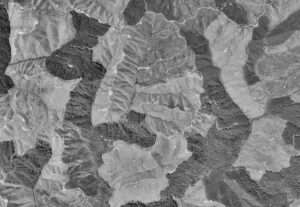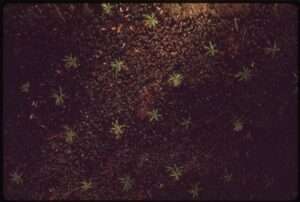
The Willapa Hills in southwestern Washington is one of the most heavily logged places. Not in current activity, necessarily, but in how much of the land has been logged at least once, and very often multiple times. Other than a few places, like Long Island and Teal Slough at Willapa National Wildlife Refuge, or the nearby Ellsworth Canyon protected by the Nature Conservancy, the old growth of the Willapa Hills has long since been chewed up for timber. And these patches, though beautiful, don’t get nearly the attention of their neighbors to the north on the Olympic Peninsula.
But I love visiting them anyway. There’s something awe-inspiring about crossing from a young doghair forest, where scraggly western hemlocks create a nearly impenetrable barrier, to the open, cool green of a remnant old growth western red-cedar forest. Sure, there are younger trees mixed in amid the ancients, along with the requisite array of shrubs, ferns, and groundcover. Compared to a logging company’s tree farm where countless Douglas fir may be packed in tightly, though, an old growth forest seems somewhat sparse.
And since commercial tree plantations far outnumber old growth and mature forests here in the Pacific Northwest, they’re what many people think of as a “forest”–the more evergreens standing, the better. Indeed, I’ve had tour participants who were confused about tree-thinning efforts in the South Bay Unit of Willapa NWR–“Why are they cutting down the trees? Don’t you want trees?” Which, of course, necessitates a discussion about how a restoration effort a few decades ago resulted in a variety of conifers being planted too thickly, and now some need to be taken out so that the rest have a better chance of growing healthier and larger, with more diverse species within their shade.

And that is where habitat restoration differs from commercial timber harvest. It’s not about how many marketable trees you can stuff into an acre and then harvest in a few decades. It’s thinking about what that entire ecosystem needs now, and fifty years from how, and two hundred years, and beyond. Yes, in a recovering forest left to its own devices you will likely get many young trees fighting for space and sun, and thinning eventually occurs through natural attrition. But when you’re deciding how many trees to plant in an acre for restoration, you’re considering what will help each individual get the best start and have the greatest chance of long-term success, not just for its own good but for that of all the other beings connected to it. So sometimes that means planting what you think will most benefit the forest in a century instead of planting every single tree you have–and saving some of the extra seedlings for another place entirely.
We can’t perfectly replicate the natural succession of an ecosystem, but we can at least nudge it along by adding back in some of the species that we’re pretty sure should be there and hope that’s enough to jump-start things sufficiently that invasive species don’t get enough of a roothold to derail the project. And thankfully we still have relatively intact old growth forests as both wellsprings of biodiversity and knowledge, and sources of inspiration. I will never live to see the trees, shrubs, wildflowers, and other plants I place into the ground as they and their descendants become part of well-established, mature ecosystems again.
But that’s okay. I don’t plant each tree thinking of short-term profit. I hold each start or seedling, each handful of seeds, with greater deliberation and mindfulness, and place it in the hopes it will be the start of something beautiful that far outlasts my time here. In this it is not the quantity of the trees that matters, so much as the quality.
